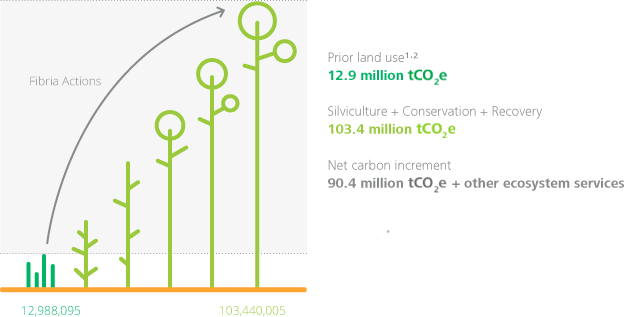With the recent shortage of water resulting from extreme climatic conditions, the importance of research on forest ecophysiology has increased, encouraging Fibria to intensify its meteorological monitoring and expand its experimental network. Below is a list of our main actions in 2016:
Increased the number of meteorological stations from 37 to 57;
Completed the development of an integrated landscape planning process based on the SWAT hydrological model (a Soil and Water Assessment Tool);
Tested recommendations considering environmental criteria, aiming to support Forest planning in the short-, medium-and long-term.
Today, Fibria has six heavily monitored watersheds, analyzing everything from rainwater inflow to the flow rate of the stream. One of the main objectives is to continuously improve understanding of the interactions between plant and climate, and the use of natural resources.

Photo Márcio Schimming.
Carbon
Fibria maintains a number of carbon-related initiatives*. Among the main initiatives are the greenhouse gas inventory, the identification of risks and opportunities generated by the inclusion of this aspect in CAPEX** processes, and the goal of doubling net carbon sequestration by 2025 in relation to 2011.
Annually, we publish our report on greenhouse gas inventory, with updated results, historical results, and clarifications on our performance. Our inventory is assured according to the standards of ISO 14064 and the Brazilian GHG Protocol Program.
We are founding members of the Brazil Climate, Forests, and Agriculture Coalition, an initiative that brings together the forestry, cosmetics, and agribusiness industries, academic and industry associations and the main climate and environmental civil organizations, to promote a low-carbon economy. We seek to contribute with the government and establish international cooperation alliances that allow for advances toward a new economic development model.
*Term that collectively represents actions related to management and sequestration of greenhouse gas emissions in a context of measuring, reporting, and pricing in accordance to different economic instruments, such as rates and taxes for CO2 emissions, carbon markets, and other restrictions or financial incentives.
**CAPEX stands for capital expenditure, which refers to the amount of money spent on the acquisition (or improvement) of capital goods by a particular company.
2016 CARBON INVENTORY (tCO2e)

1 Considering the prior use of the land as grasslands.
2 Considering the carbon inventory as 29.5 tCO2e/ha (standard value for planted grasslands, according to the Second Brazilian Inventory of Emissions and Anthropic Removal of Greenhouse Gases.
Internal Carbon Pricing
In 2016, Fibria created a task force that evaluated and indicated references for calculating an internal carbon price (shadow pricing). As a result, we defined prices for the ton of CO2 equivalent in each context: USD 5 for sequestration in forests, USD 10 for industrial and logistics emissions, and USD 30 for new technologies.
Our purpose is to acknowledge and communicate the value added of our planted forests and conservation areas, to understand the impact of taxation on greenhouse gas emissions, and to create solutions aligned with a low-carbon economy. After determining the internal carbon price, we were able to, for example, valuate in BRL 309,000 the reduction of CO2 emissions in the transportation of wood using our PIFF truck fleet in 2016.
The task force also considers that the company should play a leading role in this field and that the dialogue with stakeholders on this aspect is important.
